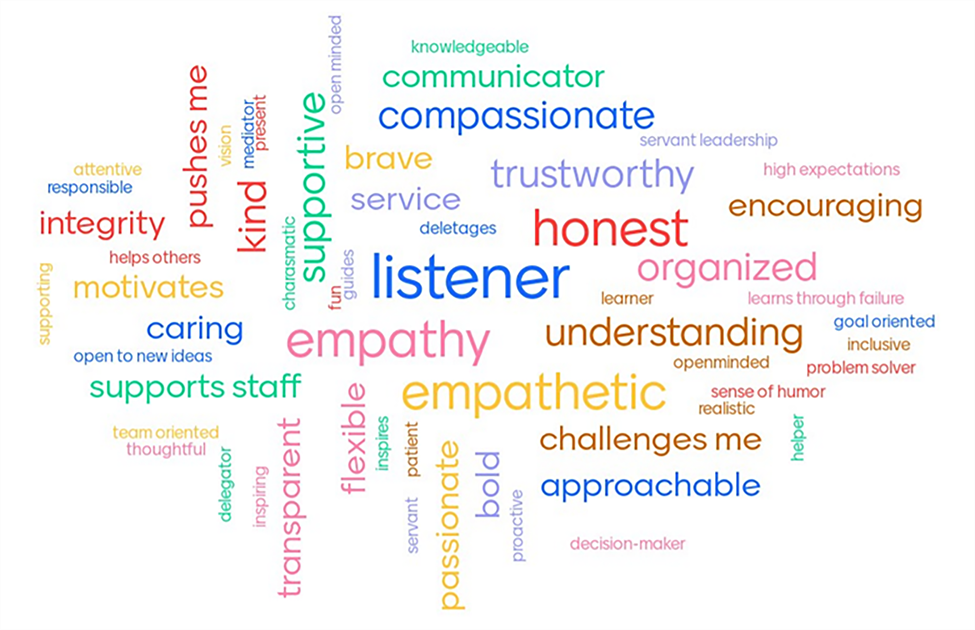Voices from the Field spotlights stakeholders in Region 12 and their work to improve educational opportunities and outcomes. R12CC is privileged to share the insights of Dr. Tammy Mitchell, Elementary Redesign Specialist, Division of Learning Services, Kansas State Department of Education.

“I would never want to be a leader! I do not want to be the boss.” This is a direct quote from a Kansas teacher I worked with prior to the COVID-19 pandemic. This teacher led their school leadership team, worked as an instructional coach, was highly respected by her peers, and served as the go-to person for her principal. I was astonished because this teacher exemplified teacher leadership, yet somehow she equated leadership with administration – being “the boss.” Leadership, however, is less about position or job description and more about personal integrity and influence.[1]
Research shows that teacher leadership develops when the school culture is supportive and when principals intentionally develop teacher leaders.[2] However, during times of unprecedented change, such as what educators are experiencing through the COVID pandemic, what does teacher leadership growth look like? To explore this question, I conducted a qualitative focus group study with teachers from schools in the Kansas Redesign Project throughout the 2020–2021 school year.[3],[4] Influenced by what that teacher thought about her own leadership role, I wondered how other teachers would describe their leadership growth given the context of the pandemic.
Three main findings from this study describe the insights of teacher leadership growth experiences.
Demonstration of Leadership
All participants reported demonstrating leadership as they took on roles and responsibilities they could not have imagined prior to the pandemic. Some such roles and tasks included: taking temperatures and general nursing duties, delivering lunches and cleaning supplies to families, and helping families navigate COVID protocols in and outside of school. Teachers across all focus groups described supporting colleagues, students, and families with greater intensity and taking on new leadership roles in their district or greater community. Teachers also expressed the need to learn how to lead themselves better. One voice from the field, a teacher from a small town in western Kansas, told of going to extreme lengths to help families with technology. “I would go to their houses and stand in the yard, yelling through the closed window to instruct parents how to get online…I did that a lot. Without [these attempts] a lot of kids would not have connected.”
Self-Described Leadership Growth
I learned through piloting the questions for this study that teachers are often humble and find it difficult to talk about themselves, so asking them to describe their leadership growth outright would have likely been met with silence. To get them talking, I asked them to express their leadership successes and failures through COVID and then talk about their perceptions of growth. One kindergarten teacher said, “Being able to handle students online and in-person at the same time was something I would never have imagined before, but it went better than I expected.” Other teachers described feeling successful because throughout the summer of 2020, they worked to learn new technology and plan for hybrid and remote learning for the upcoming year, so they felt more prepared. Teachers also described a kind of collective efficacy, where they coached each other, elevated and encouraged each other, and experimented with new strategies—frequently adapting “on the fly” at an unprecedented pace.
Participants were open about their failures, as well. One teacher stated, “No matter how engaging my lessons might have gotten over time, I could not compete for my student’s attention with 13 other people living in a small house and siblings who were fighting and crying.” Another teacher stated that in March of 2020, when Kansas schools first closed, “I just short-circuited and wasn’t there for my colleagues. It was hard for me to say, ‘I don’t know what to do, and I don’t know where to lead you.’”
Early in the interview, I asked participants to use Mentimeter to brainstorm a list of skills and attributes of the best educational leader they had ever worked for. Then, after talking about successes and failures, I asked them to reflect on terms in the word cloud that resonated and could help them describe their own leadership growth. One teacher said, “Resilient. I grew in resiliency. If you weren’t resilient this year, I think you probably already quit…but we still have to be there for the kids.” Another teacher said, “I feel like I grew in sense of humor. We’ve learned to laugh a lot because, you know, I think we’ve cried a lot too.” A different participant shared that she felt like she hadn’t grown at all. She described feeling compassionate one minute and angry the next, “I just feel like it’s inconsistent.”
Figure 1 displays a consolidated word cloud with all terms that teachers used to describe leadership growth.
Principal’s Support of Leadership Growth
As the role of the principal is critical to teacher leadership growth, I asked participants to describe how their principal supported leadership development through the pandemic. Some were able to elaborate on their principal’s support. A few expressed experiences that were not positive. The majority, however, were quiet during this part of the interview. Teachers who responded said that even through COVID, principals supported them by intentionally:
- Giving timely and actionable feedback while maintaining high expectations
- Providing opportunities to practice leading and opportunities to debrief
- Extending trust and belief
One teacher explained, “She [principal] was empathetic and did all she could to check in with us, but she didn’t lower her standards.”
Figure 1 – Teacher Leadership Growth Word Cloud

Lessons Learned
These insights provide lessons learned on teacher leadership growth that may provide helpful considerations for school leaders as we continue to face long-term unprecedented change.
Teacher leadership is action-not title-oriented. Teacher leadership develops when the principal’s actions and the school’s culture create a positive environment for growth and exploration.[5] The pandemic put this theoretical framework through a rigorous test. Compounding the challenges of building and sustaining a learning culture during a crisis, teachers sometimes did not see themselves as leaders beyond the classroom. Many tended to equate the idea of leadership with being an administrator or “the boss,” but when leadership was described as an action instead of a title, it opened up opportunities for everyone to perceive themselves and act as leaders.[6]
Teacher leadership growth requires principal’s to practice both directive and shared leadership. Principals balance many different roles, and crises pull them in many directions simultaneously. Many principals discussed in this study were highly occupied with the managerial aspects of ensuring a safe and healthy environment, and rightly so. Some situations require directive leadership—and certainly in times of crisis, teachers look to the principal for direction.[7] The principal must keep communication open, foster collaboration, and provide order or structure within the chaos.[8] Directive leadership, however, must be balanced and shifted to shared leadership whenever possible because empowering, transformational leadership improves teachers’ motivation and commitment to the school, influences school culture, and increases teacher efficacy.[9]
President Abraham Lincoln said in his annual message to Congress on December 1, 1882,
The dogmas of the quiet past are inadequate to the stormy present. The occasion is piled high with difficulty, and we must rise with the occasion. As our case is new, we must think anew and act anew. We must disenthrall ourselves, and then we shall save our country.[10]
As we emerge from the COVID-19 pandemic—an experience fraught with challenges—and work to help students and families contend with the aftermath of social–emotional consequences, mental health needs, and learning loss, we must also think anew and act anew (Lincoln, 1862). The pandemic accentuated and compounded opportunity gaps and racial disparities that previously existed but were hidden or ignored. Teachers have grown their leadership capacity exponentially throughout the pandemic, utilizing their voice and influence to support their students. We must continue to elevate and develop teacher leadership and resist the temptation to get back to “normal” because normal was inadequate. It will take all of us at every level of education to lead with strength and courage, to disenthrall ourselves with the education system of the past, and redesign the system to meet the needs of each student.
[1] Heifetz, R., & Grashow, A. (2009). The practice of adaptive leadership: Tools and tactics for changing your organization and the world. Harvard Business Press; O’Malley, E., & Cebula, A. (2015). Your leadership edge. KLC Press.
[2] Katzenmeyer, M., & Moller, G. (2001). Awakening the sleeping giant: Helping teachers develop as leaders. Corwin, A Sage Publishing Company.
[3] Mitchell, T. (2021). Developing teacher leadership during unprecedented times of change [Doctoral dissertation, Kansas State University]. K-State Research Exchange. https://krex.k-state.edu/dspace/bitstream/handle/2097/41694/TamraLynnMitchell2021.pdf?sequence=1
[4] During spring of 2021, five online focus group interviews with four to eight participants in each group were held to explore teacher leadership. This study included 16 elementary (grades K–6) teachers and 14 secondary (6–12) teachers. Most participants were core content or classroom teachers, but there were also music and special education teachers, library media specialists, instructional coaches and a counselor. Two building administrators also participated. Three participants were male and 27 were female.
[5] Katzenmeyer, M., & Moller, G. (2001). Awakening the sleeping giant: Helping teachers develop as leaders. Corwin, A Sage Publishing Company.
[6] Angelle, P., & M. Teague, G. (2014). Teacher leadership and collective efficacy: Teacher perceptions in three U.S. school districts. Journal of Educational Administration, 52(6), 738–753. https://doi.org/10.1108/JEA-02-2013-0020; Heifetz, R., & Grashow, A. (2009). The practice of adaptive leadership: Tools and tactics for changing your organization and the world. Harvard Business Press; O’Malley, E., & Cebula, A. (2015). Your leadership edge. KLC Press.
[7] Goodwin, B., Rouleau, K., & Lewis, D. (2018). Curiosity works: A guidebook for moving your school from improvement to innovation. McREL International.
[8] Heifetz, R., & Grashow, A. (2009). The practice of adaptive leadership: Tools and tactics for changing your organization and the world. Harvard Business Press; Moeckel, D. (2020, December). Leadership considerations for Kansas redesign schools [Presentation]. Kansas Redesign Apollo II Training, Topeka, KS, United States.
[9] Dumay, X., & Galand, B. (2012). The multilevel impact of transformational leadership on teacher commitment: Cognitive and motivational pathways. British Educational Research Journal, 38(5), 703–729. https://doi.org/10.1080/01411926.2011.577889; Ibrahim, M. S., Ghavifekr, S., Ling, S., Siraj, S., & Azeez, M. I. K. (2014). Can transformational leadership influence on teachers’ commitment towards organization, teaching profession, and students learning? A quantitative analysis. Asia Pacific Education Review, 15(2), 177–190. https://doi.org/10.1007/s12564-013-9308-3
[10] Lincoln, A. (1862, December 1). Annual message to Congress: Concluding remarks [Speech]. Annual Message to Congress, Washington D.C.
